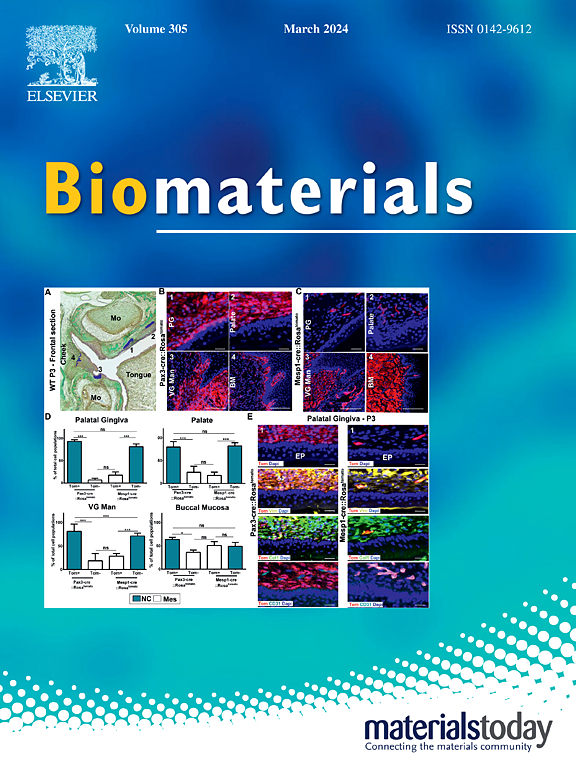Thiol-ene photoclick hydrogels reinforced with poly(protocatechualdehyde)-coated gallium doped bioactive glass nanoparticles for scarless healing of infected wound
IF 12.8
1区 医学
Q1 ENGINEERING, BIOMEDICAL
引用次数: 0
Abstract
Complex pathological microenvironment mainly characterized by excessive inflammation, reactive oxygen species (ROS) production, drug-resistant bacterial infection makes wound rapid scarless healing still a major clinical challenge. Inspired by skin composed principally of collagen and mucopolysaccharides, an injectable nanocomposite hydrogel with immunoregulation, antioxidant and antibacterial activity based on allyl glycidyl ether grafted gelatin (Gel-AGE), cysteamine grafted hyaluronic acid (HA-CSA) and poly(protocatechualdehyde)-coated gallium doped bioactive glass (PPA@GaBG) nanoparticles, was designed for treatment of infected wound. The PPA@GaBG/Gel-AGE/HA-CSA (PGBGH) hydrogel can be rapidly formed via thiol-ene photo-click chemistry between Gel-AGE and HA-CSA. In PGBGH hydrogel, the presence of core-shell PPA@GaBG significantly enhanced the antioxidant ability of hydrogels and M2 polarization of macrophages, as well as improving mechanical and tissue adhesive properties of the hydrogels via the formation of Schiff base bonds between PPA and gelatin/skin tissue. Moreover, the PPA shell effectively inhibited the ion burst release of Ga3+ observed in GaBG/GH hydrogels, which improved the biocompatibility of the PGBGH hydrogel while maintaining excellent antibacterial activity. As a result of multiple functions of the PPA@GaBG, the PGBGH hydrogel promoted angiogenesis, granulation tissue formation and re-epithelialization with improved deposition ratio of collagen III/I, which achieved the rapid scarless healing of infected wound.
聚(原儿茶醛)包被掺杂镓的生物活性玻璃纳米颗粒增强的硫醇烯光点击水凝胶用于感染伤口的无疤痕愈合
以过度炎症、活性氧(ROS)产生、耐药细菌感染为主要特征的复杂病理微环境使得创面快速无疤痕愈合仍然是临床面临的一大挑战。受皮肤主要由胶原蛋白和粘多糖组成的启发,设计了一种可注射的具有免疫调节、抗氧化和抗菌活性的纳米复合水凝胶,该水凝胶基于烯丙基甘油醚接枝明胶(Gel-AGE)、半胱胺接枝透明质酸(HA-CSA)和聚(原儿茶醛)包被镓掺杂生物活性玻璃(PPA@GaBG)纳米颗粒,用于治疗感染伤口。凝胶- age /HA-CSA (PGBGH)水凝胶可通过凝胶- age和HA-CSA之间的巯基光点击反应快速生成PPA@GaBG/Gel-AGE/HA-CSA。在PGBGH水凝胶中,核壳PPA@GaBG的存在显著增强了水凝胶的抗氧化能力和巨噬细胞的M2极化,并通过PPA与明胶/皮肤组织之间形成席夫碱键,改善了水凝胶的力学和组织粘附性能。此外,PPA壳有效抑制了GaBG/GH水凝胶中Ga3+的离子爆发释放,提高了PGBGH水凝胶的生物相容性,同时保持了良好的抗菌活性。由于PPA@GaBG的多种功能,PGBGH水凝胶促进血管生成、肉芽组织形成和再上皮化,提高胶原III/I的沉积比,实现感染创面的快速无疤痕愈合。
本文章由计算机程序翻译,如有差异,请以英文原文为准。
求助全文
约1分钟内获得全文
求助全文
来源期刊

Biomaterials
工程技术-材料科学:生物材料
CiteScore
26.00
自引率
2.90%
发文量
565
审稿时长
46 days
期刊介绍:
Biomaterials is an international journal covering the science and clinical application of biomaterials. A biomaterial is now defined as a substance that has been engineered to take a form which, alone or as part of a complex system, is used to direct, by control of interactions with components of living systems, the course of any therapeutic or diagnostic procedure. It is the aim of the journal to provide a peer-reviewed forum for the publication of original papers and authoritative review and opinion papers dealing with the most important issues facing the use of biomaterials in clinical practice. The scope of the journal covers the wide range of physical, biological and chemical sciences that underpin the design of biomaterials and the clinical disciplines in which they are used. These sciences include polymer synthesis and characterization, drug and gene vector design, the biology of the host response, immunology and toxicology and self assembly at the nanoscale. Clinical applications include the therapies of medical technology and regenerative medicine in all clinical disciplines, and diagnostic systems that reply on innovative contrast and sensing agents. The journal is relevant to areas such as cancer diagnosis and therapy, implantable devices, drug delivery systems, gene vectors, bionanotechnology and tissue engineering.
 求助内容:
求助内容: 应助结果提醒方式:
应助结果提醒方式:


